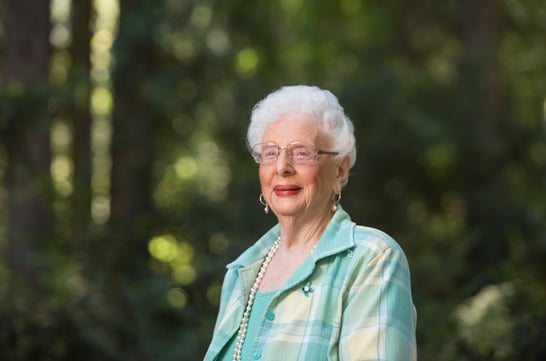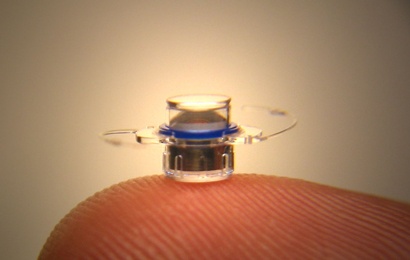 Most of us have heard of macular degeneration, which eventually robs people of their eyesight. But, have you heard about a new procedure done at UC Davis Medical Center that has restored a woman’s eyesight? The patient led a very interesting career for 40+ years and started losing her eyesight shortly after retirement. Due to a new technology, she can now see her friends and family’s faces, read and enjoy the beautiful sights around her.
Most of us have heard of macular degeneration, which eventually robs people of their eyesight. But, have you heard about a new procedure done at UC Davis Medical Center that has restored a woman’s eyesight? The patient led a very interesting career for 40+ years and started losing her eyesight shortly after retirement. Due to a new technology, she can now see her friends and family’s faces, read and enjoy the beautiful sights around her.
Virginia Bane was a trailblazer, both as a female business leader and an early embracer and purveyor of cell phone technology in circa-1980s Silicon Valley.
So when age-related macular degeneration stole her central vision after retirement, naturally she welcomed an innovative solution.
 In a first-of-its-kind procedure for Northern California, UC Davis doctors implanted a pea-sized telescope in Bane’s eye, gradually restoring her ability to see faces, colors and print. Today the 92-year-old still enjoys reading, seeing friends and living independently – thanks to both her pioneering spirit and what she fondly calls her “bionic eye.”
In a first-of-its-kind procedure for Northern California, UC Davis doctors implanted a pea-sized telescope in Bane’s eye, gradually restoring her ability to see faces, colors and print. Today the 92-year-old still enjoys reading, seeing friends and living independently – thanks to both her pioneering spirit and what she fondly calls her “bionic eye.”
“The outcome of this is one of the most wonderful thing I've had and if I didn't have it, I could not appreciate the things I see today,” Bane said at her Pollock Pines home. “I can see my family. I can see people's faces that I could never see before. I can see outside and long distance in my yard that I would not have been able to see without the scope.”
A leading cause of blindness
Bane was familiar with both technology and medicine from her 40-year business career, mostly spent in management during an era of relative gender inequality in the workplace. She started her first management job at 23 and retired 40 years later as the president of several corporations that provided pager and cell phone service, repairs and physicians’ exchanges in the Bay Area and Southern California.
“I had around about 70 employees between the corporations, and dealt with the attorneys and government agencies for licensing, but it was very rewarding,” Bane said. “It was very difficult, but I enjoyed every bit of it.”
It was soon after her retirement to a new painting hobby that Bane’s eyesight began its gradual decline due to age-related macular degeneration, a fairly common disorder among senior citizens and the leading cause of blindness in the U.S. for patients over the age of 60.
“There is no pain with it, so at first you don't realize that you have it. I noticed it mostly in my reading and then of course, trying to draw,” she said. “Because of the light and the dark, and the shadows, it was very difficult to distinguish if something was in front of me at that time. It got so bad that at 84 I stopped driving my car.”
The disease affects the retina. Bane reached a point where she could no longer see images on an eye chart, and could only detect a doctor’s hand when waved directly in her face.
“This means you can't see the faces of your family members, you can't read a book, you can't watch TV,” said Jennifer Li, an associate professor of ophthalmology who cared for Bane at the UC Davis Eye Center. “There are a lot of things that we take for granted every day that people with this condition are unable to do.
“As you can imagine, patients like Virginia really suffer a lot from their disorder. They lose a lot of sense of independence.”
New treatment option
Bane came to the Eye Center after she reported seeing purple through one eye, a trait that stumped her local physician (“I went to UC Davis because they are advanced in everything about the eye,” Bane said). In 2012 the center was able to offer her a new technology, the implantable miniature telescope.
The pea-sized device is fixed in the eye and has two lenses that help magnify an image to about three times normal size, allowing the user to utilize undamaged parts of the retina. Users still wear glasses to adjust their focus from reading to distance.
The device, approved by the Food and Drug Administration in 2010, is the only medical/surgical option available that restores a portion of vision lost to the disease. UC Davis Health System's Eye Center, in collaboration with the Society for the Blind, is one of the few in California and the nation to offer the innovative procedure.
Bane would be the first patient in Northern California and among the first 50 individuals in the U.S. to receive the implant. Candidates must be 65 or older with untreatable end-stage, age-related dry-form macular degeneration, with no other ocular diseases such as glaucoma and with adequate peripheral vision in the second eye.
“I've been very fortunate in that some people can go completely blind, and I have been able to still maintain and see things through the eyes,” Bane said. “When I had the opportunity to have the telescope lens implant, I was excited and ready to go.”
Hard work
UC Davis cornea specialists Li and Mark Mannis implanted the scope. As expected, Bane did not wake from the hour-long procedure with immediately improved vision. Use of the device involves an extensive yearlong process of “visual rehabilitation” with UC Davis occupational therapists to adjust the brain to the larger image the telescope produces.
“They're going to use the telescope to look for things with the center part of their vision, look at faces, watch TV, try and read – but they still need their other eye to help them move around, to make sure they don't bump into things and to allow them to continue to be mobile,” Li said. “A lot of the training requires them learning how to use their eyes again and learning which to use under what circumstances, so that they’re able to go back and forth easily without thinking.”
The regimen involved twice-weekly appointments and hours of practice at home – trying to “find” the scope, teaching the other eye to resist taking it over (which causes double vision) and learning to move the device from place to place to enable reading. Several weeks into training, things seemed to gel.
“I was sitting looking at TV, and golf was on,” Bane said. “All of a sudden, I could see the ball go into the little cup. I was thrilled to death because I knew then I’d ‘found’ the scope.”
Bane had high praise for her occupational therapist, Terri Hayward.
“She’s wonderful, she has the patience for everything – and she was learning at the same time I was because I was the first one to have the scope,” Bane said. “She did a marvelous job for me and I know she does for everyone.”
Restored independence
Three years out, Bane has vision ranging from 20/80 to 20/100, which equates to very readable letters on an eye chart.
“I couldn’t see, couldn’t read, couldn’t see the faces of other people, couldn’t see anything on TV unless I was sitting right on top of it,” Bane said. “With the scope, then of course, I can do all these things. Say if I'm watching television, I can tell you what color eyes people have, describe their faces and everything, the things that I could never have done before.”
The improved vision should remain indefinitely, Li said, thanks in no small part to Bane’s enthusiasm and training discipline.
“She's achieved a lot of her (vision) goals, and hopefully she'll be able to continue doing the things that she enjoys for the rest of her life,” she said.





